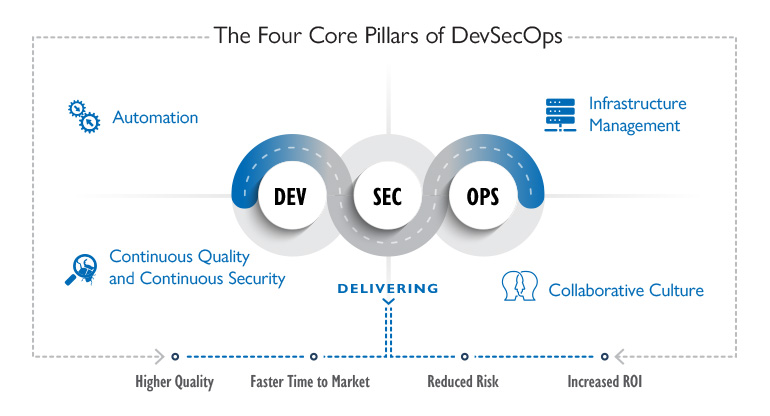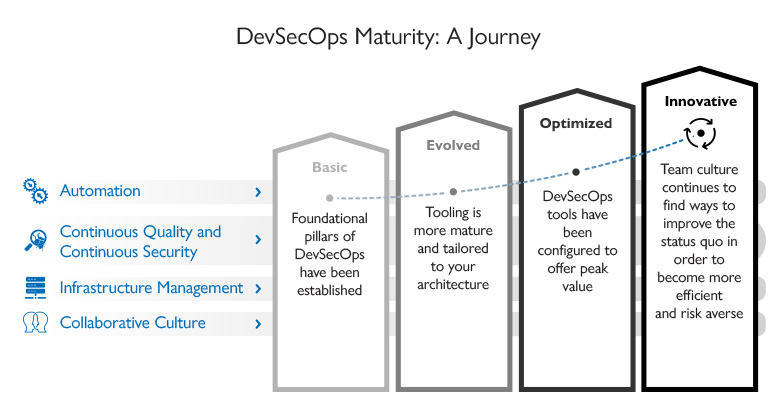 08-24-2021
08-24-2021
As government organizations shift to agile cloud computing platforms, shared storage and data, and dynamic applications, development teams are progressively adopting a DevSecOps mindset to keep up with the rapidly evolving IT landscape. While definitions vary, DevSecOps can be described as a union of people, processes, and technologies designed to integrate security and quality throughout the development process, increase delivery frequency, and foster collaboration between traditionally siloed teams. Regardless of how your organization defines it, successfully implementing DevSecOps is a journey.
To achieve DevSecOps success takes more than simply starting a practice; it requires moving the practice up the maturity curve to achieve the most value from the methodology. In order to do this, it’s critical for organizations to set up a foundation for success and approach DevSecOps as an ongoing journey that will be refined and shaped incrementally, driven by insights gathered through continuously monitoring and measuring effectiveness.
The foundation for success
The key to DevSecOps success lies in anchoring the practice with established principles proven to enable development teams to maximize the value of the methodology. Below, we illustrate the four core pillars of DevSecOps that form the foundation of a successful practice.
DevSecOps pillar 1: automation
DevSecOps promotes end-to-end automation, where traditional development lifecycle activities are delegated to an automated workflow for greater efficiency. Continuous integration and continuous delivery, or CI/CD, accelerates the time it takes to successfully integrate and validate code from weeks to minutes. When developers check in code changes, automated scripts trigger a scheduled or user-initiated build-test sequence. The code is then pulled automatically into a managed environment that builds the application and runs a series of tests to confirm the new code successfully integrates into the master code branch and functions as intended. By incorporating CI/CD, development teams release code more frequently, detect defects earlier, and shorten the overall development cycle. Most importantly, a mature CI/CD process produces a codebase that is always deployable and production ready. Automation also applies to post-production activities; teams can leverage tools to automate application recovery and scale infrastructure to meet performance demand.
DevSecOps pillar 2: continuous quality and continuous security
DevSecOps helps organizations embed security and quality deep in the heart of their development and deployment processes. Development teams can identify and address code issues earlier, not only by automating test processes via CI/CD, but also by checking for security and quality issues early in the lifecycle, as code is checked into source control. In DevSecOps, everyone is responsible for both elements. For example, developers can implement pull requests to conduct rapid, web-based peer reviews of code prior to integration. Security teams can also automate quality scans and static code analysis to detect code inefficiencies or vulnerabilities and immediately alert developers for remediation. Similarly, operations teams leverage server and application monitoring tools to identify issues in post-production and minimize risk. By using a variety of quality mechanisms, development teams collectively evaluate code quality and security at every step of the development lifecycle without sacrificing delivery frequency.
DevSecOps pillar 3: infrastructure management
DevSecOps champions the use of infrastructure as code, or IaC, to automatically build and manage environments in the same way one would automate software development tasks. In today’s IT landscape, where almost all of our platforms (on-prem and cloud) are hosted on virtual machines, IaC enables developers to write standardized scripts to automatically provision infrastructure according to customer security standards in a consistent, repeatable, and scalable manner. In other words, IaC allows your team to quickly spin up secure development, test, and staging environments with a single push of a button, then spin them back down again when they’re not in use, thereby reducing dependencies, increasing cost savings, and accelerating time to deployment. IaC also supports continuous quality by enabling teams to track server configuration changes for efficient infrastructure-related troubleshooting and increased auditability. In this way, DevSecOps not only enables your development teams to automatically integrate quality and security into software, but also into its underlying infrastructure.
DevSecOps pillar 4: collaborative culture
DevSecOps ultimately extends far beyond process automation, integrated security, and quality. As the name suggests, DevSecOps breaks down silos between development, security, and operations teams, effectively giving each team equal responsibility for ensuring the security and quality of the product delivered. In fact, the very foundation of DevSecOps success in any organization is dependent on the adoption of a collaborative culture to efficiently achieve a common goal. For example, while automated toolchains allow developers to identify quality and security issues much earlier, it also requires them to communicate with each other and across other teams more frequently. The culture of DevSecOps runs counter to the traditional image of the solitary developer working for weeks on software before they are “ready” to deliver it. Instead, DevSecOps fosters a culture of joint problem-solving, collective responsibility, and frequent communication throughout the development lifecycle.
While even one of these capabilities would yield significant benefits, these four pillars together form a strong base for a successful DevSecOps practice. From this foundation, development teams can begin to deliver higher quality software products while drastically reducing overall operational risk and increasing return on investment. However, in order to maximize the value of the methodology, organizations must move up the maturity curve and continually build upon this foundation.
Moving up the maturity curve
With a strong DevSecOps foundation in place, organizations can begin to move up the maturity curve, incrementally building on and improving their practice to maximize value. The journey is an incremental and community-driven undertaking. Organizations must devote a great deal of time and effort to not only establish new automated processes and tools, but also educate their teams on a variety of security practices that they were likely not responsible for in their siloed job role. Moreover, the journey along the maturity curve does not follow a strict, one-size-fits-all roadmap. Your organization may need to experiment with various combinations of tools, processes, and communications before finding the right mix that meets your unique needs. In order to advance along the maturity curve and truly reap all the benefits that DevSecOps has to offer, organizations must continually monitor and measure the effectiveness of their DevSecOps practice to demonstrate success and identify opportunities to improve or innovate.
Measuring the results of your newly established DevSecOps practice can be challenging. Depending on their specific business goals, organizations use a variety of metrics to measure and identify the strengths and weaknesses of their DevSecOps practice across each of the four pillars and help determine the next steps on their DevSecOps journey. Fortunately, many of these insights can be leveraged directly from your initial tool sets. Once implemented, DevSecOps tools can generate massive amounts of meaningful data (e.g., quality and security metrics, deployment frequency, application performance, and compliance reports) to demonstrate alignment to business objectives and help drive operational improvements. To maximize this benefit, these tools must be continually tailored, integrated with one another, and managed as part of your mature DevSecOps practice. For example, teams can leverage chat ops tools like Teams and Slack to plug into your development tools and sprint management tools to generate immediate feedback loops, enrich reporting, and provide full lifecycle visibility across team members and stakeholders alike. A highly integrated toolchain enables your organization to gather meaningful data that informs operational improvements to drive DevSecOps maturity and maximize the value of your investments.
DevSecOps maturity is not a destination; it’s a journey whose trajectory for success is rooted in the four core pillars that provide the critical foundation for a strong DevSecOps practice. With this foundation in place, organizations can incrementally move up the maturity curve, evolving and scaling their capabilities to achieve their unique business objectives and boost overall efficiency, quality, and security. Over time, development teams will incrementally integrate and configure automated toolsets to facilitate a proactive and predictive security posture while generating rich insights and real-time feedback to inform future maturity efforts. As the DevSecOps practice matures, your organization will not only steadily increase the speed, frequency, and quality of your deployments, but also foster a team culture centered on innovation and collaboration, ready to solve current and future challenges in an ever-evolving IT landscape.





